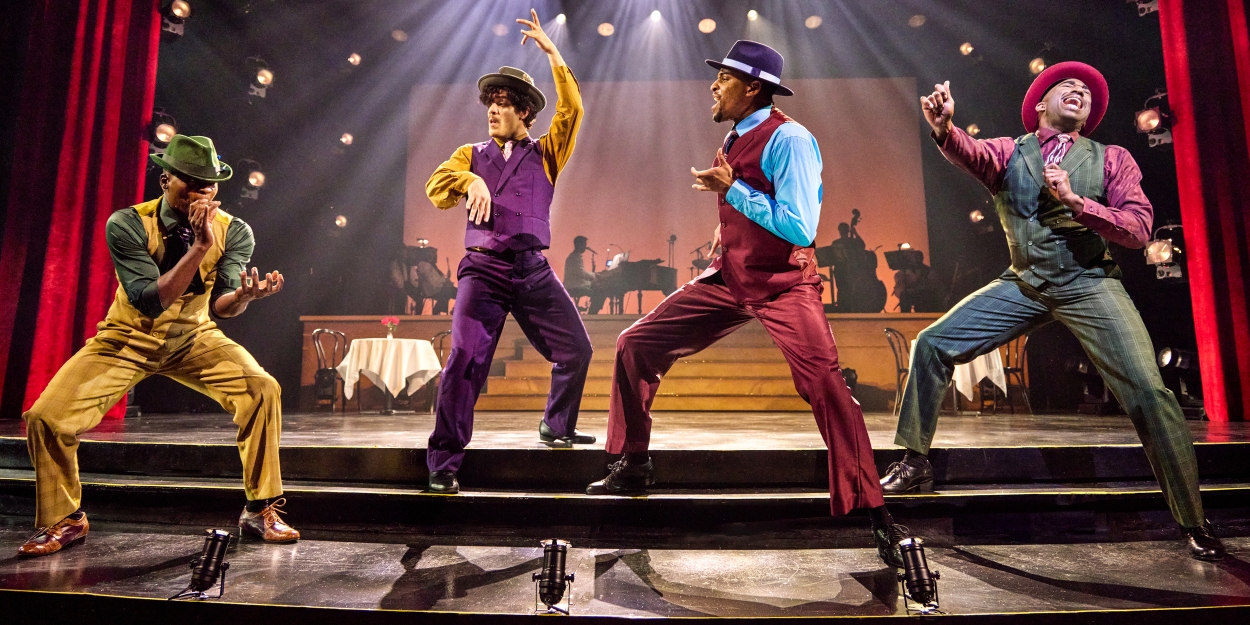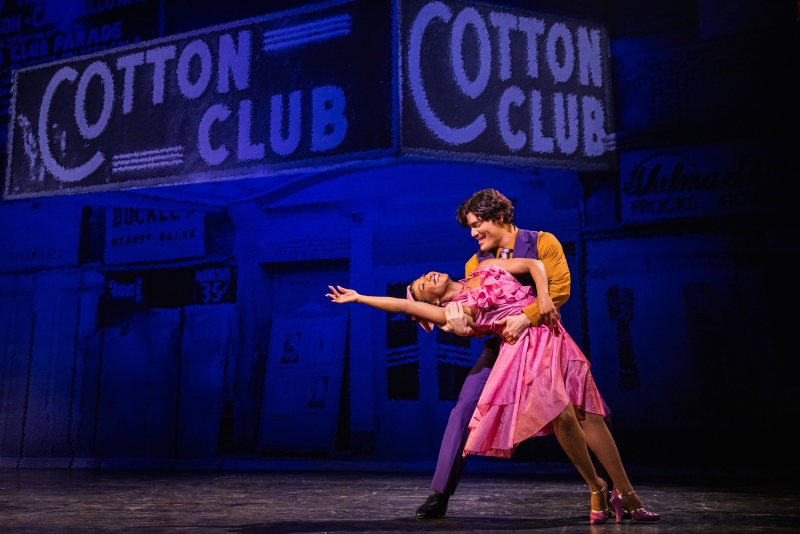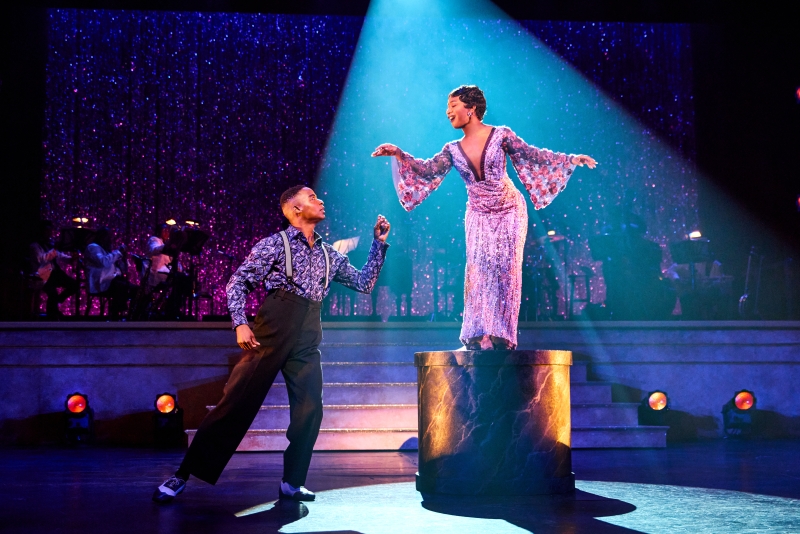Interview: Dominique Kelley & Jen Bender on Co-Directing AFTER MIDNIGHT at Paper Mill Playhouse
Now through February 25th, 2024.

Paper Mill Playhouse is currently presenting After Midnight, co-directed by Dominique Kelley and Paper Mill Playhouse’s Associate Artistic Director Jen Bender and choreographed by Kelley. BroadwayWorld sat down with the co-directors of the production to learn more about their process and bringing the Jazz Age to life at Paper Mill.
Conceived by Jack Viertel, this Jazz Age rhythm and dance extravaganza is an electrifying musical revue that transports you to the Cotton Club of the Harlem Renaissance, an unparalleled time in New York City when jazz and swing were king. After Midnight intertwines the poetry of Langston Hughes with songs from big-band legends Duke Ellington, Cab Calloway, Harold Arlen, Dorothy Fields, and more. The exhilarating score features such hits as “I Can’t Give You Anything but Love,” “Stormy Weather,” “On the Sunny Side of the Street,” and “It Don’t Mean a Thing (If It Ain't Got That Swing).”
After Midnight stars Angela Birchett, Sasha Hutchings, Joshua Lamar, James T. Lane, Stanley Martin, Aramie Payton, Destinee Rea, Awa Sal Secka, Liv Symone, Harris Matthew Turner, Jasmine Pearl Villaroel, and Anthony Wayne.
How did you both come to co-direct After Midnight, and what drew you to this particular production?
DK: We both have to thank Mark Hoebee at Paper Mill Playhouse for setting this partnership up. He’s better than Tinder..haha. Mark was sitting in on the dance auditions for The Great Gatsby, originally at the Paper Mill, and I believe he had the idea then and there to pair Jen and I together. After Midnight in a way is the exact opposite of the aforementioned project in size and story but similar in time period and energy. That was a great challenge for me as well as a way to show different facets of my work within a 3 month span in one venue.
JB: Mark Hoebee met Dom during Gatsby auditions and couldn't stop raving about his choreography. He's the one who suggested Dom and I pair up to direct. From our first Zoom meeting, it was clear this was going to be a really fun partnership! It was like we'd already know each other for years.
I was drawn to the show because it's set in a particular place and time but beyond that, there is very little in the actual script and score about how it should be presented. Knowing we had all of the vibrancy and history of the Harlem Renaissance to draw from, we were able to create our own world for the show.

How did the collaboration between the two of you develop throughout the process of directing this show?
DK: The great part about this new partnership is from day one we were aligned with the vision of the show. When entering a new partnership there is a period where you’re throwing out ideas to see what sticks. You’re also feeling out taste level, work style, creative process and strengths. Eventually this turned into phone calls where we’re spitballing about numbers and finishing each other’s sentences about where the number can go. It was pretty seamless to be honest, and I’m fortunate to have found a partner such as Jen.
JB: We were definitely feeling each other out at the beginning! Dom has an incredible career that spans Broadway, TV, film, and concert tours. Most of my career has been working on musicals so initially, I wasn't sure where we'd find our common ground. We're basically the same age so we have the same cultural references. Our jumping-off points were more from things we had both seen than how we work in one medium or another. As Dom says, it was very seamless. One of us would have an idea and the other would say, "Yes! And if we do that, what about...?" That kept repeating until opening night!
What challenges did you face in integrating the poetry of Langston Hughes with the iconic music featured in After Midnight?
DK: Some challenges were making the audience actually lean in and connect with the deliverer of the text. Sometimes it’s but a couple lines... other times it’s half a page. It is all pertinent and important and serves to paint a picture as well as turn the page but how do you make an audience care? In casting James T. Lane, who skillfully made the text poetic as well as accessible, we found an artist who could make us lean in and ingest the words he was speaking.
JB: What one person takes away from any poetry may be very different than how another person hears it. Once that poetry has music underneath it and around it, it means there are now even more variables about how someone receives it. We wanted to make sure that when people hear Hughes' words, they FEEL like the sound of Harlem. So in a way, the poetry is another instrument in the band.
Can you discuss the significance of the Cotton Club setting for this production and how you aimed to recreate its atmosphere?
DK: The Cotton Club setting is the staple and focus of the piece. Harlem, NY, where the Cotton Club was located, was a hotbed for Black music, culture, art, poetry, liberation and growth. We aimed to recreate the atmosphere by not necessarily adding a lot of scenic elements but merely focusing on the artists and denizens who you would see there. Jen brilliantly thought of the show as a 3 act play with the first act being outside of the club on the streets of Harlem. Act two was inside the club before the patrons arrived and act three was performances taking place at the Cotton Club. Our amazing scenic and lighting designer, Adam Honore, did a magnificent job creating the world that we were able to play in.
JB: It was important that if we were going to tell a story set in the Harlem Renaissance that we make Harlem a main character in our story. The original production only showed the inside of the club. We wanted to show the world of Harlem in which the club existed.
How did you approach casting for such a musically and historically rich production, and what qualities were you looking for in your performers?
DK: The original show on Broadway had a cast of around 20 artists who specialized in varied talents from hip-hop/eccentric dance to tap to singing to ballet. Our much smaller production had 10 artists who were true triple threats. We wanted to find 10 amazing people and we would slot them into different tracks instead of going by what was laid out before. We had no ensemble so our cast supports each other in solo numbers as well. It was an embarrassment of riches to be able to find artists who can dance as well as they sing and be able to go from soloists to a cohesive group often cheering for each other from the wings.
JB: We went into the audition process with the goal of finding the most dynamic triple threats and building the show on their individual talents. When you see them performing together as a group, it's almost like meeting the citizens in a small town. Everyone has a different role and when you put them all together, you have a thriving community that's greater than the sum of its parts.
The production features elaborate scenic, lighting, costume, sound, and hair/wig design. How did you coordinate with the design team to achieve a cohesive visual and auditory experience?
DK: Not only was it Jen and my first time working together but all of the design team have never worked with each other before. It was important to find an all Black creative team to bring this piece to life even if that meant finding our groove in a truncated time. As co-directors we did a tag team/breakthrough and conquer approach. We tried our best to address any design concerns as quickly as possible. It became slightly easier to stay in alignment because we weren’t trying to update the show and “update” it in any way. We wanted the audience to feel as though they were transported back in time as best as possible.
JB: The most exciting part of collaborating with designers is that everyone brings their own aesthetic to the room and then we see where those aesthetics overlap with the vision that Dom and I had for the production. A lot of that happens during the interview process. We chose our designers because it felt like we were envisioning the same production. Once we started tech and were all in the theater together, we were able to say "More of that. Or less of that." and find our way together in real-time.
After Midnight is a celebration of big-band legends like Duke Ellington and Cab Calloway. How did you decide which songs to include in the show, and were there any that were particularly challenging to stage?
DK: We are the first regional theater to debut the show and for that we are thankful. With Jack Viertel’s blessing, we could alter the show slightly to suit our needs. We decided to keep all the songs listed. With that came some challenges as to placement of songs in order to give our audience as well as our cast a chance to catch their breaths. We only switched the order of one song but we kept every other song in. Most of the songs got a new treatment in a way to really get to know the characters at the Cotton Club but the people performing those roles. As a choreographer, the 2 hardest numbers for me to stage were “I’ve Got the World on A String” and “Black and Tan Fantasy” because they were memorable numbers in the original. One used balloons and the other used a coffin. I believe we did a great job altering it to best suit our show with a new shine that will make it memorable to Paper Mill audiences.
JB: There are 26 songs in the show, which were chosen by Jack Viertel when he conceived the show. Part of the fun of staging songs that stand alone is that some of the things Dom and I conceived for the "story" changed once we got into rehearsal. For Example, "Go Back Where You Stayed Last Night" was originally conceived to be a busier comic number. When we heard Awa sing it with such simplicity and power, we changed the whole thing on the spot to something that is technically simpler but has more impact than our first idea.

How does After Midnight speak to contemporary audiences, and what do you hope they take away from experiencing this slice of history?
DK: It speaks to contemporary audiences to see the commonality of the movement, song structure, fashion, and dance moves back then and now. For example, Christina Aguilera and many pop artists have covered “Stormy Weather.” The eccentric dance scene in “Creole Love Call” can be seen as the precursor to popping, waving, animation, gliding and many other street dance styles. Any of the fashion and hairstyles seen onstage can walk down the runway of New York Fashion Week and the like. The little slice of history has and continues to inspire present-day creators.
JB: This music is timeless. Contemporary audiences know "It Don't Mean A Thing" even if they have no idea who wrote it or when. We hope they'll recognize that American pop musical can trace its roots back to these songs.
In what ways did the production evolve from its conception to its debut at Paper Mill Playhouse?
DK: Jen may say something totally different but it didn’t change too drastically from what I envisioned the show to be. When it came to costumes, we thought we were going to have everyone in one signature color and only add or subtract clothing items or accessories. For anyone that came to see the show or even saw publicity photos knows that concept was a definite switch. We fell in love with soo many garments of clothes that we had to keep adding and layering. Who was originally supposed to sing certain songs changed but not too much. We went into the process basically creating a good amount of numbers on the spot because we had such a hold on the period and storytelling. Sometimes you have to plan and then throw it all away and get in the room and create magic.
JB: I agree with all of that! The only notable difference is that the show evolved from what was essentially a very bare bones vision of the costumes and sets to a production that is more visually vibrant and full. As the show came to life in rehearsal the design needed to expand in terms of color and variation to match what was happening with the staging.
Why must audiences come and see the show?
DK: Audiences must see this show because there is no show out right now that is quite like it. I like to say it was the entry point or gateway drug for many who do not think they will enjoy musical theatre, people unfamiliar with this time period, and others unfamiliar with the scope of Duke Ellington’s music. It's a fun night out for the whole family and a celebration of Black history and artistry that is the very foundation of many music, fashion, and dance styles seen today.
JB: The show is pure theater magic. There are no tricks or huge set elements. It's the power of great music, great band arrangements, and incredible performances. And because the show is based in jazz music, the show is never the same night to night. The band is onstage and the performers come right to the edge of the stage so audiences can really feel the impact of those performances because they're up close and personal!
Photo Credit: Jeremy Daniel & Evan Zimmerman for Murphy Made
Videos

